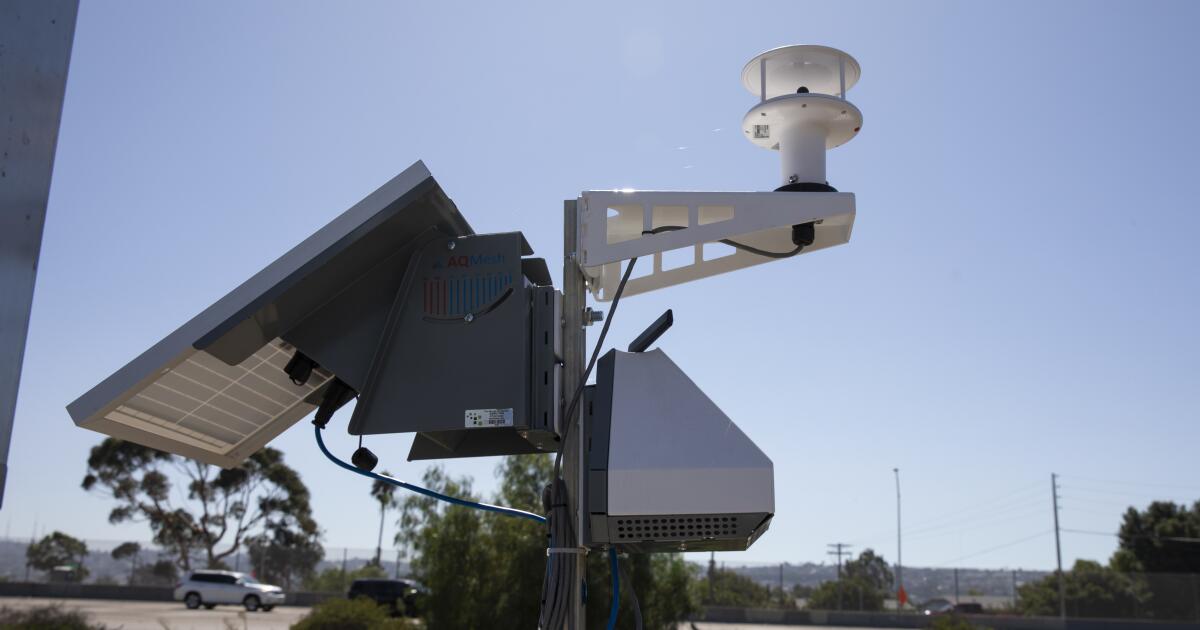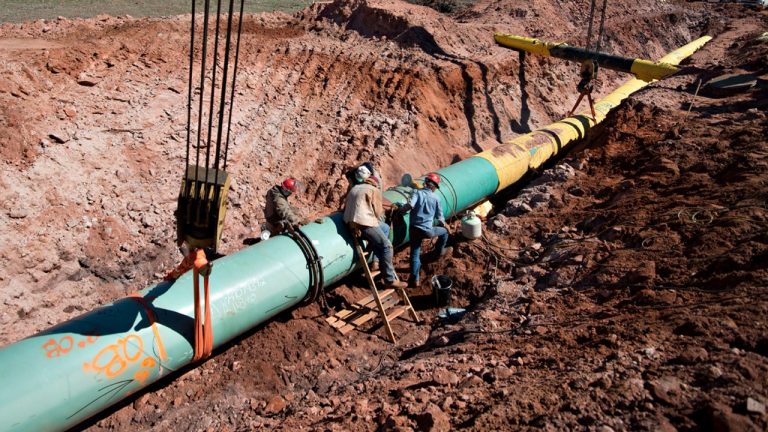
It’s only the first of six monitoring stations that will be placed along the border region near where sewage flows through the Tijuana River watershed, but in the three months since it was installed, it has confirmed what South Bay residents long suspected: The air they are breathing is unhealthy.
What, they wonder, will the other five monitoring stations show? And how will the data collected be used to remedy the decades-long, unchecked discharge of contaminated water from the U.S.-Mexico region?
Since late September, six monitors came online at a station the San Diego County Air Pollution Control District built on the property of San Diego Fire Station 29 in San Ysidro. The air-quality monitors are measuring, on an hourly basis, the quantities of the potentially toxic gas hydrogen sulfide, which has a characteristic rotten-egg odor. Their data shows that people have repeatedly been exposed to low levels of the gas that sometimes exceed state and federal air quality standards.
“The data is consistent with the anecdotal reports that we’ve been receiving for a long time that the odors are there and that, at minimum, they cause a quality of life issue for the people who are close to the areas where these odors are being detected,” said Imperial Beach Mayor Paloma Aguirre. “What’s really concerning is that we don’t know what the long-term effects of this exposure are.”
The monitors also detect levels of sulfur dioxide, carbon monoxide, nitrogen dioxide and other gases that contribute to poor air quality.
No data on these chemical compounds has been collected around the clock in the area until now. The early findings support what many residents in Imperial Beach, San Ysidro and the surrounding South County communities have been saying for years: The millions of gallons of sewage-tainted water that routinely flows over the border are emitting gases that cause irritating and often nauseating odors, gases they are breathing and that are impacting their way of life.
An inoperable wastewater plant in Mexico, a pipeline rupture and a failing wastewater plant in the San Diego region that serves as a backstop for Tijuana’s sewage have resulted in discharges to the canyons, the Tijuana River and the Pacific Ocean. Though infrastructure improvements were made in the 1990s and new efforts on both sides of the border are underway, Tijuana’s wastewater facilities have not kept pace with its population growth. Poorer communities also remain unconnected to the city’s sewer system.
The San Diego County Air Pollution Control District’s monitors, which they obtained through a $100,000 federal grant after residents raised concerns about odors, are showing just how much is in the air and when. Officials hope the information will clarify the true severity of long-term exposure to wastewater gases and help motivate decision-makers to curb sewage pollution swiftly.
All six monitors in operation at the San Ysidro station are capturing data from the air that flows through them. To get a more complete image, the district is working to relocate five of them across South County.
Among the locations eyed: city hall and at or near the pier in Imperial Beach, the communities of Nestor and Otay Mesa West, and at or near the South Bay Wastewater Treatment Plant in the Tijuana River Valley.
Imperial Beach city officials said an agreement that would allow the district access to the city’s property will be finalized soon. Port of San Diego officials, who own the pier, said they are in talks with the agency about doing the same. San Diego Parks and Recreation officials said they are also in discussions to add the San Ysidro Athletic Area Larsen Field as a potential site.
While waiting for agreements to get penned, the district is paying close attention to the recorded levels of hydrogen sulfide. It is a colorless gas in emissions from various sources such as geothermal fields, human and animal waste, landfills and sewage treatment facilities.
According to the California Air Resources Board, humans can detect hydrogen sulfide at the low level of 0.03 parts per million or 30 parts per billion. The U.S. Occupational Safety and Health Administration’s odor threshold is even lower at 0.01 parts per million or 10 parts per billion. Prolonged exposure to concentrations between 2 and 5 ppm (2,000 and 5,000 ppb) “may cause nausea, tearing of the eyes, headaches or loss of sleep,” OSHA guidelines say. After 48 hours, death may result at levels of 100 ppm or higher.
Here is a breakdown of what the monitors have detected since Sept. 28.
Concentrations of hydrogen sulfide sometimes spiked above the state’s air quality standards at 30 ppb and they repeatedly surpassed OSHA’s odor threshold at 10 ppb, meaning levels of the gas have often been above naturally occurring quantities.
The highest recorded level was 43.45 ppb at around 7 a.m. on Oct. 5.
Seemingly, there is a correlation between higher temperatures and higher concentrations of the sewer gas. Levels were the highest in early October when temperatures reached the low to mid-80s during the day.
Residents in Imperial Beach, San Ysidro, Nestor and parts of Chula Vista and Coronado took to social media, testified at government meetings and wrote to their Congressional and Legislative representatives expressing frustration over having to decide whether to shut their windows in the middle of summer or tolerate the sewage stench that infiltrated their homes. Some even paid visits to their physicians this summer complaining about their eyes burning or asthma returning.
Days after rainfall leading up to the Christmas holiday and when temperatures were in the low 60s during the day, the monitors detected either no concentrations or low levels below 3 ppb.

All six monitors are assigned a color and number, as indicated above. They document levels of hydrogen sulfide from the end of September through mid-December. Levels above 10 ppb are considered above typical background concentrations, but generally lower than the point at which long-term exposure may cause health effects.
(Courtesy of the San Diego County Air Pollution Control District )
Exposure to high levels of hydrogen sulfide is well documented, but little is understood about persistent exposure to low levels.
A July 2023 paper published by University of Michigan researchers on the topic found that “exposure to much lower levels, below 0.03 ppm (30 ppb), has been associated with increased prevalence of neurological effects” and increments below 0.001 ppm (1 ppb) “have been associated with ocular, nasal, and respiratory effects.” They said, however, that long-term community-based studies are needed to confirm findings.
But not much has been done over the years. A paper on the same subject from more than 20 years ago arrived at the same conclusion, calling on “the need for further studies.”
Aguirre said she believes the information will help in making a stronger case for getting residents some type of relief.
“We’ve been hearing a lot from folks who couldn’t open their windows (because of the foul odors) and had to have these filters in their homes,” she said. “Why do people need to pay out of their own pockets for these types of devices?”
The California Coastal Commission has joined the call for more to be done about the sewage crisis after officials from the agency visited South County in October to hear directly from those most affected by the pollution. Alarmed by testimonies and commissioners’ own experiences during their stay, the commission agreed to request that the county start conducting epidemiological tests.
“(A)ll I could smell was poop,” said Chair Donne Brownsey about the commission’s visit to Imperial Beach. “This is what (residents) talked to us about all day long. … I’ve never been to a coastal community where if there’s a beautiful beach, that I haven’t walked on it. And I didn’t walk on this beach.”
As all monitors go online from their sites, David Sodeman, chief of monitoring and technical services with the district, said the data they collect will be shared with the county Public Health Department, state and federal agencies and interested health researchers to get a better understanding of how long-term exposure is affecting people’s health.








